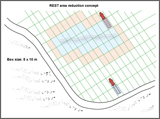Mine sweeper for enviromental chemists - not a game!
Background: Mine searchers currently investigate whether the pace at which the dogs work may be accelerated by using a modification called Remote Explosive Scent Tracing (REST): instead of taking the dogs into the mine field, samples from the soil surface of the mine field are collected. The most common procedure is to vacuum pump dust from the soil surface and to store the collected dust in containers. Typically, dust from a stretch of 100 m length and 2 m width can be combined in one sample. Sampling is done from a mine-proof vehicle or by walking and collecting from mine-free lanes, e.g. cleared by mine proof vehicles). After collecting, the dust samples are taken to a central unit (i.e., remote to the field) where the samples are subsequently analyzed by the mine detection dogs. Compared to taking the dogs into the field, this method is advantageous in that
Question: For mine detection dogs it is important that they are trained on an odour signature pattern that is as similar as possible to the one that they encounter on the soil surface above mines in the actual mine clearing operation. Do you think that training on military grade TNT is a reasonable thing to do? (TNT is the stuff that is contained in most mines. Besides 2,4,6-TNT it typically contains a few percent of 2,4-DNT.)
|
|





 Question 3
Question 3



